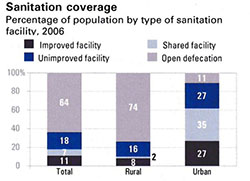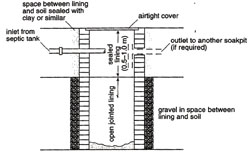Use 'Print preview' to check the number of pages and printer settings.
Print functionality varies between browsers.
Printable page generated Sunday, 9 November 2025, 5:34 PM
Hygiene and Environmental Health: 19. Liquid Waste Management
Study Session 19 Liquid Waste Management
Introduction
In general, in Ethiopia the management of liquid waste is poor. In the previous study session, you were introduced to the concepts and principles of waste management. In this session, you will learn the definitions of key terms in liquid waste management. You will also identify the types and sources of liquid waste and learn about the different liquid waste disposal methods. We will also consider the issues to be taken into account when choosing sanitation technologies.
Do you remember the definition of sanitation used in Study Session 1?
Sanitation was defined as the prevention of contact between humans and waste.
According to the World Health Organization, sanitation generally refers to the provision of facilities and services for the safe disposal of human urine and faeces. It therefore means much the same as liquid waste management. Sanitation methods aim to decrease the spread of disease by ensuring that wastewater, excreta and other wastes are adequately treated. This session will help you to respond to the sanitation needs of families and institutions.
Learning Outcomes for Study Session 19
When you have studied this session, you should be able to:
19.1 Define and correctly use the key words printed in bold. (SAQ 19.1)
19.2 Identify the types and sources of liquid waste. (SAQ 19.1)
19.3 Describe some different methods of liquid waste disposal. (SAQ 19.1)
19.4 Identify issues to be considered when choosing sanitation technologies. (SAQ 19.2)
19.1 Types and sources of liquid waste
In Study Session 18 you learned that liquid waste includes human waste, sullage, industrial waste and runoff (also referred as storm water or flood water).
What is the difference between sewage and sullage?
Sewage includes human wastes (i.e. faeces and urine), as well as wastewater from various sources. Sullage is the wastewater that arises from domestic activities such as washing in bathrooms and kitchens, including water from food preparation and dishwashing; it does not contain human excreta.
Human waste and sullage can arise from public institutions such as schools, as well as from individual households. Industrial waste arises from different industries as a result of processes to produce goods and services. The content of industrial waste may vary depending on the type of industry, the raw materials (inputs) used and the processes undertaken. Industrial waste may be toxic and thus hazardous in nature, or it could contain non-hazardous substances. Therefore, unlike the other types of liquid waste, some industrial wastes may require special treatment before discharge from the industry.
Runoff is simply flood water that arises from rain or the release of collected water from a pond or dam. It can carry many types of wastes along with it, including human waste. Therefore, it is potentially harmful to the health of the community. Liquid waste is also produced in healthcare facilities but this will be dealt with in detail in Study Session 23.
19.2 Management of liquid waste
Management of liquid waste focuses on finding a way to dispose of the waste in a way that is safe for humans and the environment. For this reason, the word ‘disposal’ is often used to mean the same as management in this context.
19.2.1 Human waste management
The basic requirements expected from a human waste (excreta) disposal method are:
- Surface water must not be contaminated.
- There should be no contamination of groundwater that may, in turn, contaminate springs or wells.
- Excreta should not be accessible to flies or other animals.
- There should be no handling of excreta; where this is unavoidable, it should be kept to a minimum.
- There should be no odours or unsightly conditions.
- The method used should be simple and inexpensive in construction and operation.
- The method should last for at least five years to be cost-effective.
In Study Session 18 you were introduced to some of the sanitation technologies that are used for human waste management. You may recall that WCs and pour-flush facilities were classed as wet or water carriage systems, also called drop-flush-and-discharge systems. The aqua privy or water privy is another in this group. Aqua privies consist of a latrine constructed above a watertight tank containing human waste and water. The wastewater from these systems is usually discharged to a septic tank or to sewers which carry it to a liquid waste treatment plant. The presence of adequate water is essential for all wet systems. For this reason, and also because of the cost involved, they are not recommended in most rural places where there is inadequate running water. For such areas, the recommended methods of sanitation are dry or non-water carried systems where there is no water needed to carry the waste offsite. In Study Session 20 you will learn more about the construction of pit latrines and other dry systems. Pit latrines are the most common type of latrine in Ethiopia.
Sanitation facilities have been classified in a different way by the WHO/UNICEF Joint Monitoring Programme (JMP), as ‘improved’ or ‘unimproved’.
Improved sanitation services or methods include:
- WC or flush toilet to piped sewer system or septic tank
- pour-flush latrine
- pit latrine with slab
- ventilated improved pit (VIP) latrine
- ecological sanitation (a type of latrine that converts human waste into useful material without damaging the environment or endangering human health).
These improved sanitation methods are described in Study Session 20.
Unimproved sanitation methods are all those that do not ensure there is no human contact with human excreta (see Figure 19.1). They include:
- service or bucket latrines (where excreta are manually removed)
- pit latrine without slab
- open latrines
- excretion in the environment (or simply, open field defecation).
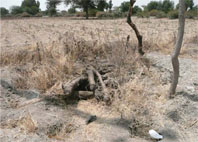
Pit latrines may be classed as either improved or unimproved depending on the presence of a slab. Why does the presence of a slab make this important difference?
The slab that covers the pit is essential for ensuring there is no contact between the waste in the pit and the person using the latrine. This defines the difference between improved and unimproved sanitation.
Figure 19.2 shows the sanitation data for Ethiopia and indicates the relative proportions of the population with access to improved and unimproved facilities. In this graph, open defecation is classified separately from unimproved methods. A fourth category, shared facilities, means sanitation that is otherwise acceptable but is shared between two or more households.
From Figure 19.2, what percentage of the rural population does not have access to improved facilities? How does this compare to the urban population?
74% of rural people use open defecation and a further 16% only have access to unimproved facilities. Therefore, a total of 90% of people in rural areas of Ethiopia do not have access to improved sanitation facilities. In urban areas, 38% of people (11% + 27%) do not have access to improved facilities.
19.2.2 Sullage management
Some people may think they can simply throw used cooking and washing water away but it should not be disposed of indiscriminately because of its negative health effects on families and community members. Proper collection and disposal of sullage is advised. Some of the disadvantages of improper disposal of sullage include the potential to contaminate the soil, pollute water sources and create favourable breeding conditions for disease vectors.
Which vectors do you think might be encouraged by sullage collecting on the ground?
Mosquitoes are likely to be attracted as they use stagnant water as breeding sites. Flies and rats might also appear as the sullage would be a source of drinking water.
Unsightliness and bad odour affect the aesthetic value of our environment, therefore proper handling and disposal of sullage is required. Sullage can be discharged to sewers or septic tanks in areas where they exist. However, in many rural areas there is no sewer system so it is necessary to construct a pit near the household to dispose of sullage properly. The pit should be filled with gravel or sand and the sullage can be allowed to percolate into the ground. A sullage pit keeps the wastewater in one place and encourages it to soak quickly into the ground. It also avoids bad odour and unsightliness in the environment.
19.2.3 Industrial wastewater management
Effluent means wastewater of any type that is discharged (flows out) from a pipe or other structure.
Effluent produced by an industry should meet the national guideline values of wastewater quality before it is released into rivers, streams or even municipal sewer systems. However, it is beyond your mandate to check on this. If you have any concerns, you should request inspection by experts such as occupational and environmental health officers in the district or higher administrative bodies. Given the expansion of agricultural-led industrialisation in rural Ethiopia, the challenge of industrial pollution is likely to increase in the future. In accordance with the law vested with the Ethiopian Environmental Protection Authority (EPA), industrialists have to undertake an Environmental Impact Assessment (EIA) and produce an Environmental Impact Statement (EIS) before they commence the construction of any new industrial development (see Box 19.1). In your role as a community healthworker, you can assist a relevant expert by providing the necessary information to your immediate supervisor to facilitate the enforcement of environmental law in your locality. You are not expected to take actions by yourself. Public health complaints by community members should also be communicated to the relevant officers for timely action.
Box 19.1 Environmental Impact Assessment
Environmental Impact Assessment (EIA) is a preliminary step in in the planning phase of major development projects. It is a systematic process of assessing the possible impacts that a proposed project may have on the environment. The process usually requires the preparation of an Environmental Impact Statement (EIS) that should report on the findings of the EIA and recommend ways of reducing or mitigating any negative environmental impacts, including possible alternative actions.
In Ethiopia, the Environmental Protection Authority (EPA) is responsible for ensuring EIAs are undertaken for major projects. Established in 2002, the EPA’s mission statement is to enhance good environmental governance through ‘removing the constraints faced by public agents, individuals, civil society and the private sector to know, explore and utilize fully their own potentials to enlarge their choices for understanding their respective functions in an environmentally sound manner’.
19.2.4 Runoff management
Runoff or storm water needs to be properly managed to ensure it does not have a damaging impact on property or health. In some areas, mostly in towns and cities, runoff is directed into stormwater canals; these need to be used properly and kept clear of debris. In rural areas, stormwater canals are rarely present; therefore, there needs to be pre-planning to effectively prevent runoff from entering households and public buildings, and running over the roads, as is frequently the case. Improperly managed flood water could cause a physical hazard to the community and can also cause outbreaks of waterborne diseases due to contamination of drinking water sources and food stocks.
To prevent the damaging effects of stormwater in your community, the likely routes of stormwater should first be identified, i.e. the location and direction of channels that tend to form in heavy rain. Once the scope of the problem is identified, then development agents, in consultation with the community leaders, can design and implement a solution. Where the community lives near dams or river banks that frequently burst during the rainy season, it is advisable to devise an early warning system at village level. This should be based on a study of past experiences and use relevant information from the local Meteorology Office and/or Agricultural Office.
19.3 Collection, storage and treatment of liquid waste
There are different sanitation technologies used to collect and store liquid waste. Some of them also treat the waste and produce useful byproducts. The various different systems are used in different circumstances depending on the location, available resources and type of waste. In this section, we will describe septic tanks and anaerobic biogas reactors. We will also briefly describe the type of centralised treatment system that may be found in larger towns and cities.
19.3.1 Septic tanks
Septic tanks are used with water carriage sanitation systems. The human waste is washed into the tank, where it is stored and partially treated. A septic tank is a watertight chamber, usually made of concrete, and is mostly under the surface of the ground (Figure 19.3). They have inlet and outlet pipes. Fibreglass, PVC or plastic tanks can also be used. The retention time of the wastewater in septic tanks should be a minimum of 19 hours but can be a great deal longer.
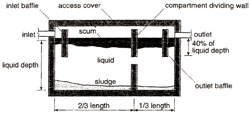
The purpose of septic tanks is for the solids to settle out of the wastewater and for anaerobic decomposition of organic solids to take place. However, the treatment in a septic tank is only partial. The solids will be broken down in the tank and diluted in the wastewater but this will still contain high levels of organic pollutants. Septic tanks should only be used in places where water is plentiful and where vacuum trucks are available to remove sludge periodically from the chamber (Figure 19.4). The process of removing sludge from the septic tanks is called desludging.
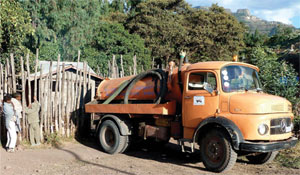 | Figure 19.4 A tanker pumping out sludge from a septic tank or latrine. (Photo: Nicholas Watson) |
Septic tanks are a storage and treatment unit to complement such facilities as WCs (cistern flush toilets), pour-flush toilets and aqua privies. The effluent from septic tanks is usually piped into a soak pit, also known as a seepage pit (Figure 19.5). A seepage pit is lined with open-jointed or porous material such as bricks or stone without mortar, which allows the wastewater to seep out slowly into the soil. Alternatively the wastewater may be spread across a drainage field using an array of pipes buried below the surface.
A septic tank has the following advantages:
- can be built and repaired with locally-available materials
- has a long service life
- presents no problem of flies and odour, if properly used
- has a relatively low capital cost (though it may not be affordable by rural households), and moderate operating costs
- does not require electrical energy because it uses gravity flow.
However, the constraints of a septic tank include the following:
- only applicable for water carriage sanitation systems
- treatment is only partial and the effluent may still contain pathogens
- sludge must be removed periodically.
19.3.2 Anaerobic biogas reactor
An anaerobic biogas reactor, also known as an anaerobic digester, uses anaerobic digestion to convert liquid wastes and other organic matter into sludge and biogas. The sludge can be used as a soil fertiliser and the biogas can be used for energy to produce heat (for use in cooking) or electricity. This affordable technology can easily be adapted by rural families and communities if appropriate training is given to local artisans and masons in the design and construction of the reactor (Figure 19.6).
The reactor consists of a chamber usually below the ground. It has an inlet for inputs (mainly human excreta) and two outlets (one at the centre for biogas, and the other on one of the sides for outlet of sludge). Addition of animal manure and vegetation will improve the efficiency of the reactor.
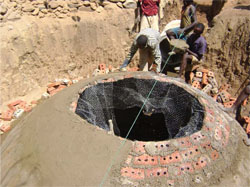
Neighbourhoods can join together to share a digester. However, if sufficient wastes are generated, individual households can each have one and get the benefit of biogas production. You should explore if local loaning enterprises could help households install an anaerobic biogas reactor.
19.3.3 Centralised wastewater treatment systems
In larger towns and cities, liquid waste may be conveyed via a sewerage network to a centralised wastewater treatment plant; for example, Addis Ababa’s waste is treated at the Kality Wastewater Treatment Facility. Simple small-diameter sewers convey sullage and sewage from individual households to larger main sewers and then to the treatment plant. (Note that the word ‘sewerage’ refers to the network of pipes and ‘sewage’ refers to the liquid waste that flows through the sewers.) This method is not likely to be used in rural and peri-urban areas of Ethiopia. In addition to sewage, industrial waste may be discharged into the sewerage network – although it may have to have special treatment (technically called pre-treatment) onsite beforehand.
19.4 Choosing appropriate sanitation technologies
By now you will have realised there are many different sanitation technologies that can be used for liquid waste management. Part of your role, in collaboration with others, is to encourage the installation of sanitation systems and help people in your community decide on the appropriate technology to use. The Federal Government’s role is limited to issuing regulations, setting standards, providing technical assistance and financing public facilities. It is solely the responsibility of the district or kebeles to mobilise the community and coordinate the activities of sanitation at grassroots level. In this process, you should understand that sanitation should be driven by informed household demand. This means that apart from technically helping households to achieve sanitation, your role is to encourage them to demand sanitation.
There are many factors to consider in the choice of technologies but before we describe these, there are some general principles to bear in mind as well.
19.4.1 General principles
Involve the users in decision making
As you now know, in its broad definition, sanitation doesn’t mean simply latrines; it involves hygiene and environmental behaviour as well. In the past, sanitation interventions used to focus on ‘hardware’ (the construction of latrines and other waste disposal facilities) instead of integrating ‘software’ (hygiene promotion and health behavioural change) components of the programme. This approach has been heavily criticised because it prescribes a single or limited technological option for the user community without involving them in the decision. People who will use the facility need to participate in the planning process, because technological choices that are imposed on them are unlikely to succeed.
Your local community
As a member of your local community, you should consider ways to stimulate and encourage local innovation and enterprise. Technologies that are accepted by people will not only meet their preferences and be affordable but also use the possible mix of local and external materials and skills, ideally emphasising the use of local resources first. Locally sourced technologies are more likely to involve local people in your village in their development, construction, marketing and use.
Sustainability
An important principle of sanitation is that it protects the environment. A sustainable sanitation system will safeguard the environment and be durable, affordable and socially acceptable. When you facilitate the implementation of human waste management, you must make sure that provision of sanitation avoids unacceptable impacts on the environment, especially surface and groundwater resources.
Finding the resources
Installing a sanitation system will require funding and human resources. The sanitation strategy of the Federal Ministry of Health of Ethiopia basically suggests ‘no subsidy’ for household sanitation.
Users or households will need to pay for the installation, operation and maintenance of latrines. However, some organisations such as The World Bank and some NGOs recognise that some people might require some form of support to achieve total sanitation. Targeted subsidies that consider, for example, people with disabilities or old people may be appropriate.
Integration with water supply and hygiene
Sanitation improvement cannot be achieved in isolation; it needs to be integrated with improvements to water supply and hygiene promotion. You should try to make a coordinated effort to combine hygiene and water supply promotion along with that of sanitation, in order to influence the behaviour of individuals and families in your community. You should work together with your local water supply and other related services to achieve better sanitation in your community.
19.4.2 Questions to consider
Now, let’s discuss factors that are important for households to consider in the selection of liquid waste disposal facilities. When families are selecting a sanitation technology with your help, there are many interrelated and variable factors that they should take into consideration. Some of these factors are decided by the geographical location you are working in and you will not be able to influence these, although it is important that you take them into account. Others are determined by the people involved and by the local situation.
What is your location?
Your geographical location will influence factors such as:
- Climatic conditions: for example, in highland areas with heavy annual rain, latrines should be constructed in such a way that prevents flooding.
- Topography and geological formations: the depth of the water table, type of rock and the permeability of the soil; sandy soils, for example, are more permeable than clay soils.
- Abundance or scarcity of water: WCs and other water carriage systems are not appropriate in areas where there is no piped water.
Who will use the facility?
The number of people, their characteristics and attitudes will all need to be considered. For example:
- Cultural acceptability: social and cultural beliefs, and the values and practices of a community, are important considerations for households when selecting a sanitation technology.
- Affordability: the choice of technology will depend on the ability and willingness to pay; the cost should be fairly low for most people to be able to afford it.
- Safety to users: a latrine should not be constructed in ways that endanger the safety of children, women or other family members who use the facility.
- Accessibility: children, elderly people and people with disabilities may need special consideration to ensure the chosen facility is easily accessible to them without discomfort or inconvenience.
What local resources are available?
It’s important to consider the local context and whether local resources can be used. This includes:
- Availability of resources and infrastructure: the presence of human skills, construction materials and other resources may make one technology more appropriate than another. In general, sanitation technologies that need less skill are important for rural households.
- Energy source and pit emptying requirements: in rural areas where a pit emptying service is not available, households will need to depend on traditional latrines.
- Demand for reuse of the waste: facilities that ultimately help households to recycle and use waste, such as composting and biogas reactors, are important considerations as well.
These are the main factors that determine the appropriateness of the sanitation technology that households choose and use. In general, the technology we choose must give a complete barrier to the liquid waste in order to protect the family’s health, while being acceptable in terms of cost (i.e. installation, operation and maintenance costs) and be socially and culturally sound.
Summary of Study Session 19
In Study Session 19, you have learned that:
- Sanitation can be defined as the means by which human excreta, as well as community wastewaters, are collected and disposed of so that they do not cause any harm to the community. It involves protection both of human health and the environment.
- Liquid waste can be classified as human waste, sullage, industrial waste or runoff. Different methods of waste management apply to these different categories.
- Human waste can be contained using wet or dry sanitation systems. Wet or water-carriage methods require easy access to a water supply and are not usually appropriate in rural areas. Sanitation systems can also be classified as improved or unimproved.
- Septic tanks offer partial, anaerobic treatment of liquid waste. The sludge has to be removed periodically and the effluent has to be disposed of via a soak pit.
- Anaerobic biogas reactors convert liquid wastes into a sludge and biogas through anaerobic processes. The sludge can be used as a fertiliser and the biogas as a source of energy.
- In urban areas, wastewater may be conveyed via sewers to centralised wastewater treatment plants.
- Choosing appropriate sanitation technologies requires consideration of many factors including the needs and wishes of the local community, local environmental conditions, costs and the availability of resources.
Self-Assessment Questions (SAQs) for Study Session 19
Now that you have completed this study session, you can assess how well you have achieved its Learning Outcomes by answering these questions. Write your answers in your Study Diary and discuss them with your Tutor at the next Study Support Meeting. You can check your answers with the Notes on the Self-Assessment Questions at the end of this Module.
SAQ 19.1 (tests Learning Outcomes 19.1, 19.2 and 19.3)
Which of the following statements is false? In each case, explain why it is incorrect.
A The decomposition of human waste in a septic tank is an aerobic process.
B A seepage pit is a watertight underground pit for containing liquid waste.
C Anaerobic digestion is a method of waste treatment that converts waste into useful products.
D Runoff does not cause environmental problems because it is only rainwater that runs off the land surface.
E Protection of groundwater from contamination is an essential requirement of human waste management.
Answer
A is false. Decomposition in a septic tank is an anaerobic, not aerobic, process.
B is false. A seepage pit must not be watertight. Liquid must be able to seep slowly out of the pit into the surrounding ground.
C is true. Anaerobic digestion of waste produces biogas and digested sludge that can be used as a fertiliser.
D is false. Runoff is rainwater running off the land but it may contain human and other types of waste that have been washed off the land surface. It can also cause flooding problems.
E is true. Human waste management must ensure the protection of groundwater from contamination.
SAQ 19.2 (tests Learning Outcome 19.4)
Explain why the following factors are important when choosing a sanitation technology.
- a.local geology
- b.local climate
- c.the age range of people using the facilities.
Answer
- a.Local geology is important because the type of rock will need to be considered for any technology that relies on liquid waste percolating into the ground. For example, a pit latrine must be sited further away from a water source if the rock is permeable.
- b.Climate can make a difference if the usual rainfall pattern causes frequent flooding. This will need to taken into consideration when locating and building the chosen latrine.
- c.The sanitation technology must be comfortable and convenient for all the people who are going to use it. Small children may need special arrangements that allow them to use the latrine without danger. Elderly people may not be fully mobile and may also need special consideration to ensure the latrine is accessible for them.
